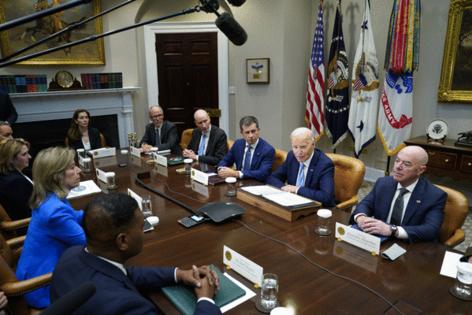Hurricane relief funds stable for now, officials say
Published in Weather News
WASHINGTON — Fears of an immediate cash crunch at the Federal Emergency Management Agency that could necessitate congressional action before the November elections receded on Tuesday after President Joe Biden raised that prospect a day earlier.
Even so, Homeland Security Secretary Alejandro Mayorkas warned of a long and extensive road ahead for Hurricane Helene recovery efforts because of what he called the “historic magnitude” of the storm in North Carolina and other southeastern states.
“The rebuilding is something that is not for today but is something that is going to be extraordinarily costly and is going to be a multiyear enterprise,” Mayorkas said at a White House briefing Tuesday.
For now, it doesn’t look like lawmakers will need to interrupt their campaigning to head back to Washington to deal with the problem, as Biden suggested Monday.
FEMA spokesperson Daniel Llargués told reporters Tuesday that the agency is in a “good position” at the moment to respond to Helene, noting that it lifted “immediate needs funding” status, which diverts available funds to only the highest-priority activities. The agency received nearly $20.3 billion on Tuesday, the first day of fiscal 2025, under the stopgap funding package Biden signed last week.
“We don’t want in any way, shape or form for anybody to think that FEMA is not well-positioned and ready to support our state partners but, most importantly, individuals that were impacted in Florida, South Carolina, Georgia, North Carolina,” Llargués said. “We have funds, we have staff and commodities ready to be deployed where needed, as needed.”
Lifting INF status means the agency could tap into the newly available funding for some $8 billion worth of longer-term relief projects dating back to prior disasters.
Still, there appears to be a sense that the latest cash infusion for FEMA’s disaster relief fund is enough to tide the agency over until the lame-duck session, when Congress could tackle a new supplemental aid package. The new stopgap bill’s expiration date is Dec. 20, which lines up with Congress’ target adjournment date for the session.
Mayorkas on Monday referred to initial search-and-rescue and response efforts as a “multibillion-dollar undertaking,” without putting a specific figure on it or a timeline on when additional funds will be needed.
A House GOP leadership aide said the $20 billion will likely last until January and that it would take at least 30 days before a full damage assessment is complete, giving lawmakers plenty of time to act after the elections.
“As Congress gets reliable information on the damage and cost estimates from the administration, Congress will act appropriately to help these communities recover,” the aide said.
Lawmakers already have $27.5 billion worth of supplemental disaster aid requests from the White House dating back to October 2023, not counting this week’s cash infusion, dealing with calamities ranging from Guam’s Typhoon Mawar to Maui wildfires to Baltimore’s Francis Scott Key Bridge collapse. That doesn’t include more recent disasters like flooding in Vermont and Texas and Hurricane Beryl, which also hit Texas.
The initial stopgap bill introduced by Speaker Mike Johnson, R-La., which was defeated, would have provided an extra $10 billion for FEMA, but that assumed an expiration date for government funding of March 28.
The older White House request from last October included big-ticket items such as $9 billion for FEMA, $2.8 billion for the Department of Housing and Urban Development and $2.8 billion for the Agriculture Department to compensate crop and livestock producers for 2023 losses.
Robert Bonnie, the Agriculture Department’s undersecretary for farm production and conservation, said Tuesday that if Congress provides additional supplemental relief to compensate farmers affected by Hurricane Helene, “those dollars can move relatively quickly depending on how Congress designs that type of assistance.”
Early-return caucus
Meanwhile, some lawmakers still want Congress to reconvene early to take up an aid package.
Rep. Jared Moskowitz, D-Fla., on Tuesday introduced legislation to tack on $10 billion for FEMA plus $5 billion for HUD. “Congress should’ve dealt with this funding shortfall before we went on recess, but now we must act swiftly to pass this supplemental,” he said.
And Rep. Mike Lawler, R-N.Y., considered one of the more vulnerable incumbents in next month’s elections, urged lawmakers to come back as well. He said Iran’s attack on Israel on Tuesday called for a new aid package for Israel’s Iron Dome and David’s Sling missile defense systems, as well as emergency hurricane relief for affected states.
Sen. Lindsey Graham, R-S.C., concurred with that sentiment. “I am reaching out to Republican and Democratic colleagues to put a package together as soon as possible,” Graham, his chamber’s ranking Republican on the State-Foreign Operations Appropriations Subcommittee, said in a statement.
Meanwhile, Biden and Vice President Kamala Harris announced plans to visit hurricane-ravaged areas on Wednesday: Biden will be in North Carolina and South Carolina, and Harris in Georgia.
According to analyst Nate Silver’s latest polling average update, North Carolina and Georgia are the closest of any states in the race between Harris and former President Donald Trump, with Trump currently less than 1 percentage point ahead in both.
Biden told reporters Tuesday, “We have to jump-start this recovery process. People are scared to death,” adding, “It’s going to cost billions of dollars to restore this area.”
_____
(David Lerman contributed to this report.)
_____
©2024 CQ-Roll Call, Inc., All Rights Reserved. Visit cqrollcall.com. Distributed by Tribune Content Agency, LLC.







Comments